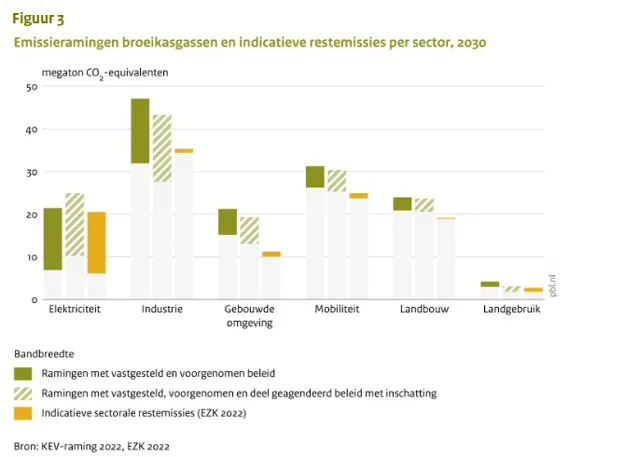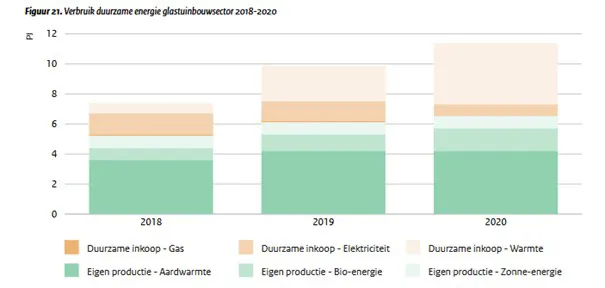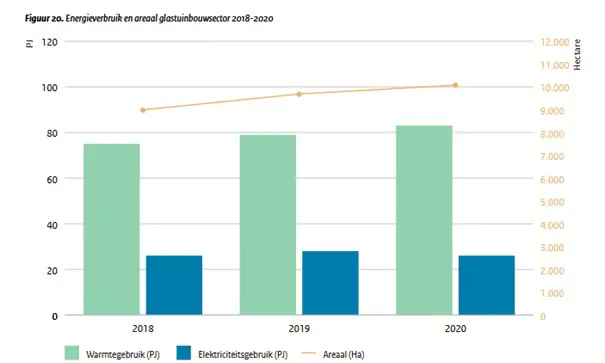To meet its climate targets, The Hague is working on policies to make greenhouse horticulture more sustainable, among other things. The question is what the effect of those policies will be. Will it help the sector meet emission reduction targets? Not at the moment, according to researchers. The government also recognizes this. The current energy crisis might very well help.
The Netherlands Environmental Assessment Agency, which carried out its annual Klimaat- en Energieverkenning (Climate and Energy Outlook or KEV), does not dare to make any firm statements on what emission reductions if any, existing and planned Hague policies will achieve for greenhouse horticulture. However, they do estimate that the sector is not going to meet its own CO2 sector targets (a residual emission of 4.3 to 4.8 megaton CO2 equivalents in 2030) (the estimate is that greenhouse horticulture will remain stuck at 5.3 megaton CO2 equivalents), while the Netherlands as a whole is also not going to meet the 2030 reduction target.

Figure 3: Emission estimates of greenhouse gasses and indicative rest emissions per sector in 2030. X-axis: Electricity, Industry, Build Environment, Mobility, Agriculture, Land use. Green: Projections with set and proposed policies, striped green: Projections with set, proposed, and partially guaranteed policy with estimates, yellow: Indicative sectoral rest emissions.
Additional interventions from The Hague
Based on current policy, the Netherlands will achieve a 41-52% emission reduction in 2030 compared to 1990, while 55% is the target. The government responds by aiming for 60% now and with additional measures so that the target will still be met. The Hague is committed to additional climate policy, amending laws and regulations (Heat Act and Energy Act), and, after research, preparing new measures and tightening climate policy. By spring 2023, this should lead to a "robust package of measures" aimed at achieving the 60% target. Besides its own policy, the Netherlands is also counting on international help, including through the upcoming climate summit in Egypt.

Greenhouse horticulture is not yet going fast enough
Despite lagging behind targets, the government sees that the transition is 'underway.' Including greenhouse horticulture, where The Hague, for instance, points to the increased share of renewable energy used by the sector. At the same time, it points out that the sector's energy consumption still increased by 2% in 2020. As causes, Hague points mainly to growers reporting their acreage better in the Agricultural Census and to more use of CHPs because of a favorable spark spread.

Energy use and area of horticulture sector 2018-2020, green: heat usage, blue: energy usage, line: area (ha).
Hopes pinned on growers themselves and a new covenant
The Hague is counting on an acceleration of the energy transition in greenhouse horticulture. This is exactly what the sector itself points to, with Glastuinbouw Nederland representing its interests. The sector itself wants to be climate neutral by 2040. The government expects the sharp increase in gas prices to lead to a decrease in energy consumption in the sector towards 2030. The researchers in the KEV count on a decrease in energy-intensive crops. The ongoing energy crisis is not a bad thing in that respect, one could argue from the Hague's perspective.
The Hague is also counting on a glasshouse covenant being agreed upon between the government and the sector as early as 2022. That, too, should ensure the acceleration of the energy transition. On 1 January 2023, there must be clarity on the 'elaboration of an individual incentive' for sustainability. The industry and the government have already agreed on this. The incentive must be introduced by 1 January 2025.
Growers may also draw their own conclusion
In the Climate Memorandum 2022, the government attributes an important role to the coherent package of measures for greenhouse horticulture presented in April this year. These include "pricing, standardizing, and subsidizing instruments." "These measures encourage entrepreneurs to take steps themselves. For horticulturists who are unwilling or unable to shape the energy transition, the package provides clarity that they will have to scale down or convert their current production," the note reads. Both the Climate Note and the KEV also refer to the recently announced energy-saving obligation. This, too, should get the sector moving. Until now, greenhouse horticulture was exempt from this.
CHPs hold their own
Although the researchers in the KEV draw no conclusion about the effect that the new policy will have on emissions in greenhouse horticulture, between the lines, there is quite a bit of information about the future of the sector. For instance, PBL assumes that the area under glasshouse horticulture will decrease (although it is cautious about current developments and, in particular, foreign influences), that cogeneration will remain in a strong position (which, according to the researchers, will thwart emission reductions) and that the demand for electricity will have passed its peak.
The KEV states that it is expected that the CO2 emissions from gas consumption by greenhouse horticulture will decrease slightly due to the complete phase-out of gas boilers, while natural gas CHP plants are expected to remain and possibly even increase in the period 2030-2040. This is then due to the assumed situation in the energy market and because the combined generation of electricity, heat, and CO2 for plant fertilization fits well with the needs of greenhouse horticulture.
CO2 emissions fall by 2.9 megatons due to a shift to less energy-intensive crops in greenhouse horticulture as a result of higher energy prices and the uncertain market situation. This leads
to lower heat demand and decreased use of natural gas in boilers. CHP plants are also making fewer running hours because their own electricity demand for lighting is decreasing.
Power feed-in for flexibility and balancing market compensation is still happening. There is also modest growth in renewable heat, such as geothermal, and ambient and residual heat supply. Lower deployment of (bio)gas CHP plants also reduces methane emissions by 0.3 megatons of CO₂ equivalents between 2021 and 2030.
"CHPs are getting in the way of sustainability"
The fact that greenhouse horticulture still relies heavily on CHPs frustrates the government's emission targets. The KEV states that CHP deployment led to increasing greenhouse gas emissions. In the period 2000-2021, greenhouse gas emissions from energy use increased from 7.7 to 8.7 megatons of CO₂ equivalents.
The higher deployment of CHP plants also caused greenhouse horticulture to become a net supplier of electricity from 2007 onwards. These natural gas- and biogas-fired CHP plants emit more methane than gas boilers due to methane slip (unburned natural gas). These methane emissions increased from 0.3 megatons of CO₂ equivalents in 2000 to 1.1 megatons of CO₂ equivalents in 2021.
On the other hand, an increase in biomass consumption since 2006 and in the use of geothermal heat from 2010 has somewhat reduced natural gas consumption and related emissions. Statistics show that, after 2019 and 2020, 2021 was another year with the high deployment of natural gas-fired CHP plants due to a favorable relationship between natural gas and electricity prices, including the tax exemption for natural gas for cogeneration. As a result, emissions did not decrease. However, it is expected that this tax exemption is going to be reduced. A proposal for limiting the energy tax exemption for natural gas use in CHPs will only be fleshed out in the 2024 tax plan.
Spark spread
Nevertheless, things do not look bad for CHPs. Again in 2021, as in past years, the researchers see an increase in CHP deployment because of the favorable relationship between the selling price of electricity and the purchase price of natural gas. In 2021, CHP deployment increased by 8% compared to 2020. A small increase in capacity is expected from 2022 onwards. Increased use of LED lighting means more electricity is left with growers for feed-in to the grid.
In 2021, and even more so in 2022, the spark spread for feed-in has now become so favorable, the researchers argue, that gas-fired CHP plants compete away heat from other options, including already existing renewable heat. Also, because the correction amount in the SDE++ scheme is linked to the gas price, with the current high gas price, the SDE++ subsidy has become virtually zero in net terms, while renewable heat generation does have operational costs, particularly power purchase and capital repayments. The use of gas boilers did decrease by 9 percent.
Fewer operating hours of CHP
In 2030, about 3,000 megawatts of CHP capacity will be taken into account. According to the KEV estimate, CHP natural gas deployment should decrease from 100 petajoules in 2021 to 82 petajoules in 2025 and 70 petajoules in 2030. Until 2030 and beyond, CHP can hold its own despite the expected increase in the sustainability of electricity generation in the Netherlands and Europe. The ensuing low and more volatile electricity prices may reduce the profitability of CHP plants, but, on the other hand, these plants can contribute to reducing grid imbalance due to their flexibility.
Operating hours do decrease significantly towards 2030, by 27 percent compared to 2021. There is also less own electricity demand for lighting, which partly explains the drop in fuel use. Gas boilers are losing their market share due to high gas prices: in 2030, they contribute to meeting heat demand with 12 petajoules of gas use, compared to 27 petajoules in 2021. The higher gas prices also lead to more incentive to save heat but less to make it sustainable. This is because sustainable heat, with relatively high investment costs and with SDE++ subsidy, has to compete with heat from CHP plants whose cost price is largely covered by the proceeds of electricity sold.
Natural gas alternatives
If growers need to get rid of natural gas, alternatives should be available. Geothermal energy is important here, as is the external heat supply. For geothermal, the researchers calculated for 12.0 petajoules of heat for greenhouses in 2030 (6.2 petajoules in 2021 from 20 projects).
In addition to natural gas, other uses include gaseous biomass. Biomass use in boilers decreased from 6.3 petajoules in 2021 to 4.8 petajoules in 2030; this is linked to the ban from 2022 on new SDE++ awards for low-temperature heat from woody biomass feedstocks. Biomass CHP plants will disappear after 2028. The use of biogas from (manure) digestion in CHP plants increased from 4.1 petajoules in 2020 to 5.6 petajoules in 2030.
External heat supply to greenhouse horticulture has further decreased: from around 15 petajoules in 2000 to 2.7 petajoules in 2021. However, this heat supply is expected to increase slightly to 3.5 petajoules in 2030 due to the expansion of existing heat networks in Westland and the construction of new heat networks in greenhouse areas.
Electricity demand over peak
Electricity demand in greenhouse horticulture showed a steady increase in recent years, up to 2019, due to the further intensification of exposed crops. In 2020 and 2021, electricity demand was slightly lower, partly due to the effects of the COVID-19 pandemic, at 8.2 and 7.9 terawatt hours, respectively.
LED lighting is expected to have an accelerated breakthrough, as it was included in the Greenhouse Horticulture Energy Efficiency Subsidy Scheme (EC scheme) in 2021. From 2022, an increasing rollout of LED lighting in greenhouses is expected, and together with a cultivation mode with less lighting, this will lead to a decrease in electricity demand to around 7.6 terawatt-hours by 2030.
CO2 supply to greenhouse horticulture gains importance
CO2 has been supplied to greenhouse horticulture for a number of years by third parties, both in gaseous and liquid form. Annual sales are around 0.7 megatons. For horticulturists who aim to make their heat demand more sustainable, the availability of external CO2 remains desirable, as they will lose their own fossil source of CO2. It also allows them to avoid 'summer heating,' where fossil-fired plants are turned on to produce CO2 in the summer when plant demand for CO2 is highest. To encourage CO2 supply, eligible categories have been included in the SDE++ scheme since 2021, where parties that capture and supply CO2 to greenhouse horticulture can receive a subsidy.
Increase in acreage is paper issue
The KEV also looks at agriculture-wide emissions from land use. Energy consumption is largely determined by greenhouse horticulture, the researchers point out. In particular, energy is used for heat. Consumption for greenhouses did decrease between 2000 and 2021 due to conservation measures, renovation, and scaling up of growing locations. Between 2010 and 2018, the acreage decreased. After that, the area increased. Better response and transmission of data by growers from 2019 onwards are cited as the main reason for the area increase. The researchers argue that it seems that the area under glasshouse horticulture actually remained fairly stable between 2010 and 2021 and amounted to about 10,000 hectares. An ongoing study by CBS-WEcR in 2022 on the area of greenhouse horticulture in the Netherlands is yet to confirm this.
The trend distribution across crops shows that it is mainly the greenhouse area for vegetables that is increasing, while the area for (cut) flowers is shrinking. For perennials, the area remains almost constant. In 2021, the average growing location size is almost 2.4 hectares per location, whereas, in 2000, it was less than 1 hectare per location.
Caution in forecasting area decline
The area development up to 2030 is uncertain. The financial capacity to invest in new greenhouses or to expand is determined by the expenditure on energy and labor and by market prices for products. As Dutch greenhouse horticulture is mainly an export-oriented sector, international market developments play a major role. The current uncertain and volatile situation in the energy market makes short- and medium-term developments very uncertain. The researchers point out that the energy crisis seems to be driving shorter crops and less energy-intensive crops. Because the longer-term effects of current events cannot be predicted, the researchers calculate a 10 percent decrease in the area under cultivation compared to 2021 (9,560 hectares).
Sources: Klimaat- en Energieverkenning 2022 en Klimaatnota 2022
.
